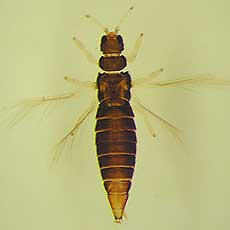
Male very rare, except in Brazil.
Heliothrips haemorrhoidalis Bouche, 1833
| Biology | |
| As its common name implies, the greenhouse thrips is a pest in greenhouses in temperate countries. Under field conditions it is usually found on plants with rather hard leaves, including tea and Pinus in parts of Africa, Rhododendron in southern Europe, and Viburnum tinus in eastern Australia. It has even been found breeding on nursery stock of the Wollemi Pine (Wollemia nobilis; Araucariaceae) in New South Wales and Queensland, Australia, and has been found causing serious damage to the older fronds of tree ferns in New South Wales. Adults and larvae move slowly, and are found on mature (not young) leaves together with pupae. The larvae raise their abdomen over the head when disturbed, and secrete a drop of dark liquid that dries to a black spot on the surface of a leaf. |  |
| Distribution | |
| Originally from southwestern Brazil (Mound & Monteiro 1998), the greenhouse thrips is now found throughout the tropics and sub-tropics on a wide range of plants. | |
| Recognition | |
| Body
dark brown when mature, but abdomen golden in less mature adults; legs
yellow; antennal segments III – V & VII-VIII yellow, VI brown
in apical half, I-II light brown; forewing pale with hind margin shaded.
Head strongly reticulate, cheeks slightly concave but constricted at
base. Antennal segments III & IV with sense cone simple; VIII much
longer than VII. Pronotum reticulate. Mesonotum not divided medially.
Metanotum with strongly reticulate triangle, median setae small on anterior
half of sclerite. Tarsi short and 1-segmented. Forewing slender with
apex rounded bearing 2 long cilia; costa with long cilia, posteromarginal
cilia not wavy; veinal setae not much larger than surface microtrichia.
Abdominal tergites II-VIII with 1 pair of dominant setae medially; VIII
with long posteromarginal comb of microtrichia; X short but with complete
median division. Sternites with 3 pairs of small marginal setae. Male very rare, except in Brazil. |
|
| Related species | |
| Two further species are placed in this genus, one from South Africa and one from southeastern Brazil (Mound & Monteiro 1998). | |